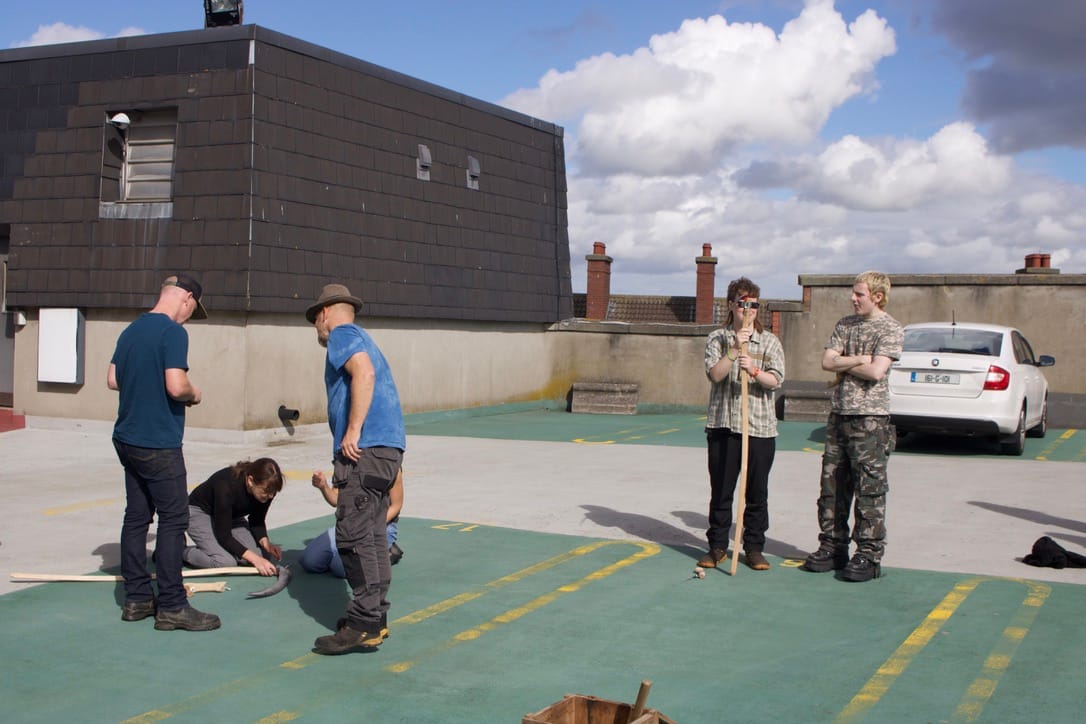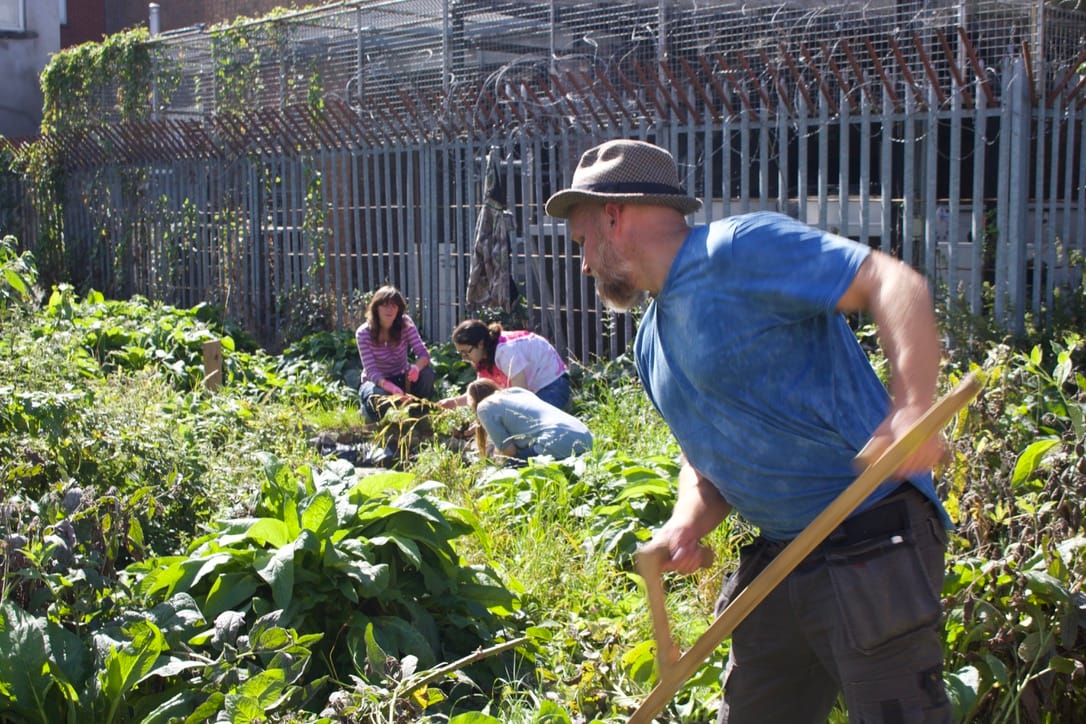Nobody caught illegally dumping yet by new north inner-city CCTV
But the scheme is a success, said a council official's report, as that shows the cameras are a deterrent.
“I don't think I can ever get used to living in the city, actually,” said one participant. “So when I heard about this opportunity, I was like, ‘Okay, this sounds like a real thing.’”

The insurance finally came through 20 minutes after the fourth annual Scythe Day was supposed to start on Monday morning.
With the go-ahead, students and professors climbed up to a car park on the National College of Art and Design (NCAD) campus on Thomas Street in Dublin 8.
They carried retired boxes from the Irish Army inscribed with bullet calibres and curved wooden poles and fasteners and long sharp blades.
Term won’t start for another week. But over a dozen former and future of Gareth Kennedy’s students showed up to this day-long event centred around the scythe – the old hand-tool used to slice vegetation, maybe best known these days as the thing wielded by the Grim Reaper.
“Big year, everyone turned up,” Kennedy said. “Perfect weather too,” he said, beneath a bright blue sky with fluffy rounded clouds.
He’d told people to wear long sleeves and gloves. Students had shown up in camouflage, leather jackets, and hiking boots.
At a bit past half past 10, they spread out on the striped black asphalt roof, and learnt about the evolution of the tool over time from 1600s Austria to today.
They heard how to assemble it, hold it, how a person should hold their body while wielding a scythe, and how to guide it through vegetation. All in preparation to strip “the field” at NCAD of its vegetation later this afternoon and hack away at the year’s growth to make way for new.
Kennedy had help from a guest host, Wexford-based scythe maker and instructor Chris Hayes.
Before Kennedy led them out into NCAD’s field just off Thomas Street, full of butterfly bushes and blackberry bushes, miniature apple trees and grass and nettles.
Scythe Day is an intro to a course that centres around this field – how to relate and impact the diverse environment.
“The students are really kind of tracking the seasonal change in the field,” he said.
He wants to make his students connect to the environment, and he realised he needed to organise that.
Student Magda Falusi signed up for his elective course because it made more sense to her than almost any other thing in Dublin, she said.
“When I was growing up, my life was completely different. Basically, we didn't have television, we didn't have a telephone, we didn't have a car,” Falusi said, on the ramp up to the car park’s roof.
She grew up in a small village in rural Hungary, she said, and grew up working the land. the land. Seven years ago, she moved to Dublin.
“I don't think I can ever get used to living in the city, actually,” she said. “So when I heard about this opportunity, I was like, ‘Okay, this sounds like a real thing.’”
“We have a couple options for electives. Like, entrepreneurship … No, thank you.”
Falusi used a scythe as a kid, she said. There and then, she said women were given smaller ones – if they were given one at all.
“Since I was a woman, no one really … no one really wanted to teach me, you know,” Falusi said. “Because it's a man's job. And look around, like it's almost all women. We enjoy greater equality here.”

Kennedy, the instructor, said he started the course centering on the field after Covid-19 first arrived in Ireland.
During that period, this fenced-off oasis in the Liberties fell into “radical disuse”, he says.
“I was teaching sculpture online with Zoom, we were all going a little bit crazy,” Kennedy said. “You don't teach sculpture on Zoom, don't do that.”
There was an appetite for outdoor teaching, he said, where they could meet face to face. So he started the course about the field.
They've done a lot of work with Marcus Collier, an associate professor of botany at Trinity College Dublin.
Collier pointed out the field’s significance – that this is one of those places where a “kind-of oddball” ecology has bloomed, Kennedy said.
This type of space has lessons in the face of biodiversity loss and climate crisis, Kennedy said.
“They have a lot to tell us about resilience. And they have a lot to tell us about what survives and what lives in spite of us,” he said.
This field, nestled in the city, but without the manicured landscape or visitors of a park, creates an opportunity for his students to make a human connection with nature, Kennedy says.
“Having them create their own stories ..in relationship to this kind of space is really, really, really, really, necessary, important, important. And has all sorts of like positive effects. Least of all, upon mental health,” he says.
It’s an art class so they’re not covering individual plants in a classroom, but in the field each week, thinking about how to create a story and a meaningful impact on and with it.
"The whole use of the space is to try and come up with a new ethical relationship with the nature and, by extension, ourselves,” Kennedy says.
Students told stories from previous years of the field course. One year, they dug a hole and made a pond, filling it with wheelbarrows of water.
Student Ali Kavanagh said the class routinely made lunch in the garden, using a manhole cover, a clean one, to cook on. “We made pancakes that had ‘Inchicore’ stamped into them,” she says.
"It's about learning as you do, and I feel it's about viewing that thing differently. It's about viewing that potato or that apple differently." said former student Ruby Doyle.
After two years of the field course, Kennedy decided to add Scythe Day to it because it was so overgrown, and he wanted to approach it with a mindful, gentle touch.
Using a scythe is a full-body experience, says Hayes, who makes and sells scythes, and teaches how to use them.
Before they started tackling nature, he led the class in bringing their shoulders to their ears, making circles from their ankles, swaying side to side gently.
It’s a bodily experience, he said. It activates everything.
Kennedy asked the students to listen for the sounds of the Liberties and nature, the sound of the scythe cutting the grass, the smell of fennel.
Work in pairs, he said. Figure out together the best techniques to manage grass, nettles, shrubbery, he said.
Hayes said using a scythe traditionally was always a team effort, social. He cuts his two acres with scythe with his neighbour now, he says.
Kennedy says he asked Hayes to help teach his students because of the way he focuses on a full-body connection to nature, and feedback loops of learning, responding to it, readjusting.
“There's an enchantment there, or a re-enchantment,” he says.
“We've been kind of a culture to think nature's elsewhere and the wild is far, far away,” says Kennedy. “When actually, you know, we- with sites like this- we have the occasion to really radically close that distance.”
Ultimately Kennedy wants his students to connect to the wild, to the patterns of the seasons, to connect in their own way.
"Ecology is about relationships, dynamic relationships, evolving relationships, complex doubtful relationships. Appreciate that,” he says. "The field is a gift, and so sweet. There's nothing quite like this place."
They cut almost all of the fresh growth that day, not the blackberries or vines but all on the ground. People were amazed at how much they got through, Kennedy said.
Kennedy was stung by a bee. He knew he was nearing a hive they just removed.
He advised that they avoid the area. Attendees saw a fox and a rabbit too.
The grass cuttings were stacked in piles to dry. They can give them to the neighbours in the Liberties with horses, Hayes said.

Falusi, the student from Hungary, felt different than she expected after, she said.
She’s holding a scythe, about to go back to work to keep hacking away at the thick nettles before her.
“I kind of feel liberated from my original thoughts,” she says. “Because I thought that I have experience. I had to reflect on that, actually. And restart from zero. And I think it was, it was really, really good to do it.”
Memories flooded back, Falusi says – of trying to learn scything on her own in Hungary, because no one would properly teach her.
“And now, I feel like I'm coming back to my roots, but at the same time I'm defying the expectation, so. And it's a very circular kind of feeling, actually,” she says. “It feels like I'm outgrowing that person that I was supposed to be.”
It isn’t excitement she is feeling for the course now, she says. She said before she came today, yeah, she had nerves.
Now though, “I'm kind of feeling the opposite. I'm feeling peace.”
Funded by the Local Democracy Reporting Scheme.